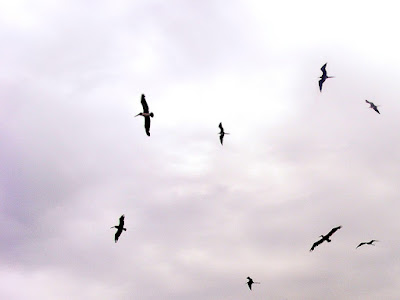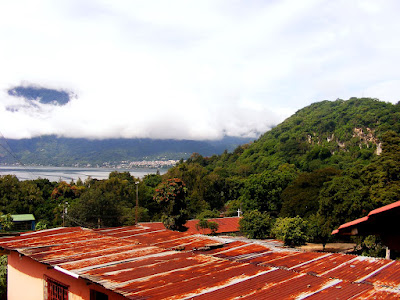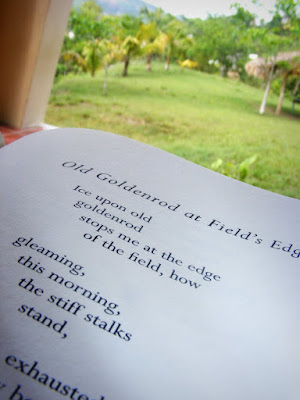I traveled
to and returned from Paradise this week. After catching one bus to San Pedro
Sula, another bus from San Pedro to La Ceiba, an overpriced taxi ride with an
incompetent taxista from La Ceiba to Nueva Arminia, and after a
night in Nueva Arminia, a wet ride in a fishing boat, I arrived with two
friends in the tranquillo community
of Chuchauate in Cayos Cuchinos, a small group of islands off the coast of
Honduras.
Turquoise
waters, clear skies, hammocks, happy children playing with crabs, coral reefs
full of fish taken straight out of Finding
Nemo (including a couple of baracuda that sent me swimming quickly to shore) – it is all there in Chuchauate. There are approximately 50 homes on
the island that is not larger than a football field, and the residents of the
island are friendly beyond belief. The children are happy and full of energy,
eager to learn new games and to build sandcastles along the shore. Days are
spent snorkeling, laying in the sun and eating heaping plates of beans,
plantains, rice and fish while watching the fishermen set off in their long and
colourful canoes to catch fish and lobsters.
It doesn’t
get much more perfect than this. When staring out at the island gems edged in
white sand, set against a backdrop of clear blue skies and waters of a million
shades of green and blue, the islands look as perfect as a contrived backdrop
in a cheap photography studio. “Tropical Paradise” is the name of the backdrop,
and it looks primed to have a harried gaggle of a family posed before it, hands
folded nicely in laps or on one another’s shoulders, smiles contrived, clothed in
Sunday best.
And perfect
it is. Until, that is, the mascara incident. After some quality snorkeling time in the coral reef surrounding the island
(did I mention that this place is perfect??) my friends set the snorkeling mascara rented out from the family we
were staying with on the beach while showing a giant hermit crab to the kids. A
few children who had been catching fish just off the shore started playing with
the snorkeling gear, and after the bustle of sunbathers left the beach it
became evident that the mascara had
miraculously acquired legs, walked into the sea, and taken up residence in an unoccupied
hermit crab shell, determined to enjoy the beauties of the coral reef for all
of eternity without being subjected to being pulled, prodded and washed in
spit by visiting tourists. At least,
such was the only plausible solution to the fact that after walking through the
village several times to ask if anyone had seen the mascara, nobody seemed to know where it
could be. Each child instantly accused a friend of having taken the mascara. When approached, said friend
would then accuse another friend of having it. Mothers of the accused children
developed walls of defensiveness when asked if they had seen the mask,
also placing the blame someone else's child.
According
to the women we were staying with, dishonesty reigns supreme on the island when
it comes to the children. The adults are fine – if an adult is caught stealing
they are not allowed to stay the island. But the children learn at an early age that
if they take something from a tourist, their parents will pretend not to see
the stolen object to avoid the embarrassment of acknowledging that their child stole something.
We
eventually gave up on the search and paid to replace the elusive mascara. Emotions ran high when I walked
with a local island resident to question other islanders with as much delicacy
as possible, knowing that bitterness that arises in a community the size of a
football field have a tendency to fester. The snorkeling gear had dominated a
portion of the day. Although still dazzlingly beautiful, the waters did not
seem quite as bright, nor the sand quite so pristine as it had when we first
landed.
Why is it
that we gravitate towards Paradise? Why do we daydream about turquoise waters
in the midst of January greys, spending hours scanning the internet for good
deals on flights to tropical destinations? Why do we contrive to establish
paradise around us, wearing fake smiles and putting on our Sunday best? Does this Paradise
even exist?
The missing
mascara reminded me of Gerard Manley
Hopkins. This is not exactly surprising; it is remarkable how often daily life
reminds me of Gerard Manley Hopkins. In the sonnet “God’s Grandeur” Hopkins exuberantly
writes about the beauty of the natural world, writing “the world is charged
with the grandeur of God. It will flame out, like shining from shook foil.” But
a tone of mourning enters the poem when a couple of lines later he mourns that “generations
have trod, have trod, have trod; and all is seared with trade; bleared, smeared
with toil; and wears man’s smudge and shares man’s smell.”
Sometimes
the existence of humanity feels more like a smudge upon the face of the earth,
when we smear our bickering and selfishness across the glorious backdrop
of God’s creation. And yet we are drawn to natural beauty like moths
to flame. Like moths surrounding a candle or a lamp on a summer's evening, our presence rarely augments the beauty that is already there. I think that it is not a coincidence that tropical paradises are not
infrequently the setting of books like The
Life of Pi and Lord of the Flies,
in which the sometimes harshness of humanity is juxtaposed alongside of
tropical beauty.
I think
that yet again Gerard Manley Hopkins grasps this idea in another poem, “Spring.”
After describing the richness and beauty of Spring he questions and answers, “What
is all this juice and all this joy? A strain of the earth’s sweet being in the
beginning In Eden garden.” We are
drawn to beauty like moths to flame, risking safety and security in the attempt
to experience something of a glory we can only remember.
It has been about a month since my last blog post. This is a bit of a clue as to how much free time I have had lately. To give an update, I am over halfway through my penultimo day in Honduras; I leave for the San Pedro airport bright and early on Wednesday. It is going to be a tough departure, but I am going to leave with the knowledge that everywhere on this earth, whether a tree-lined street in Vancouver or an island in the Caribbean, is filled with the glorious "strains of earth's sweet being in the beginning in Eden garden." No place is going to fully live up to the memory of Eden garden - we humans carry too baggage for that - but at the very least I can strive to continue to listen to those strains wherever in the world I am.




















































